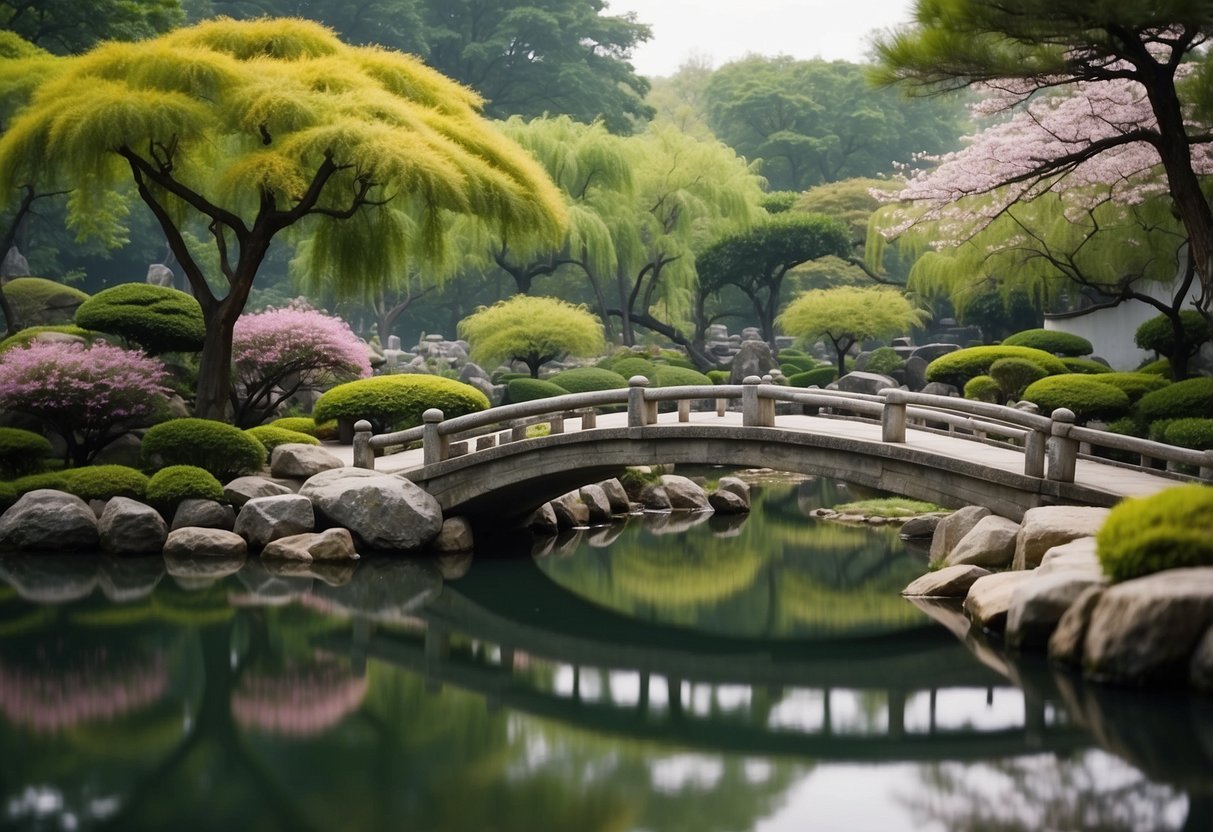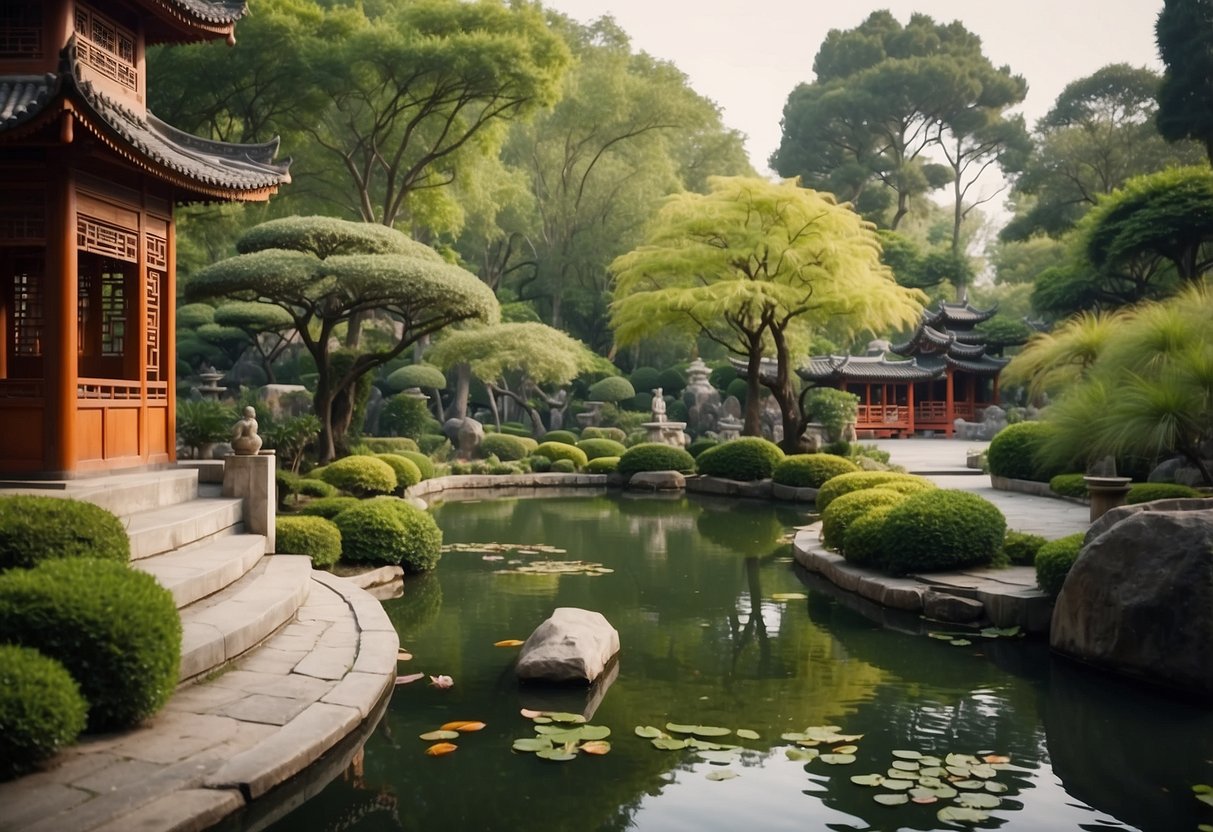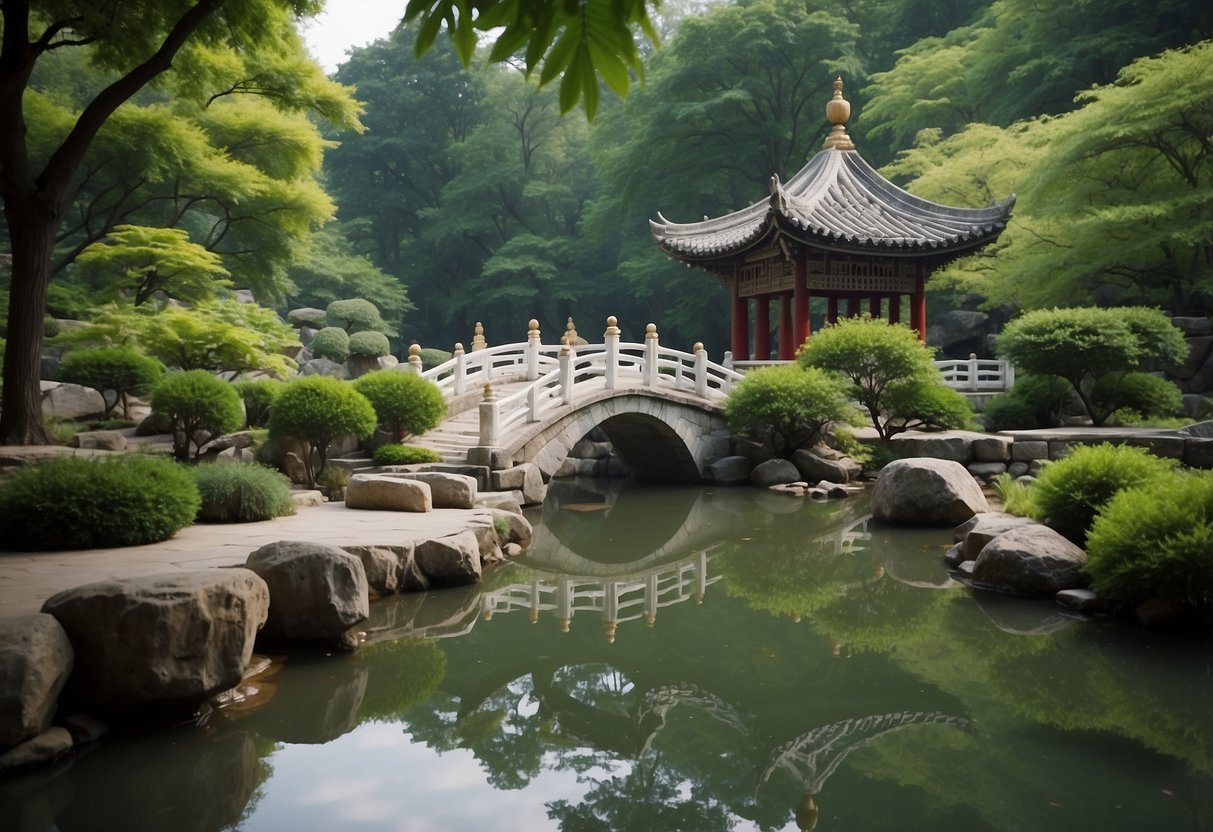Chinese Garden Ideas: Creating Tranquil Outdoor Spaces
Creating a Chinese garden can transform your outdoor space into a serene and beautiful retreat. With the harmonious balance of natural elements and elegant design, these gardens offer a peaceful escape from the hustle and bustle of everyday life. Imagine strolling through a garden filled with bamboo, water features, and traditional ornaments that bring a sense of tranquility and beauty.

Why choose a Chinese garden for your home? Chinese gardens are designed to delight the senses and provide a space for relaxation and reflection. They combine elements of nature with thoughtful design to create an environment that feels both timeless and refreshing. Whether you have a large yard or a small patio, incorporating Chinese garden ideas can enhance your outdoor living area.
1) Bamboo Pathways

Bamboo pathways bring an elegant and natural feel to any garden. Imagine walking along soft bamboo edges that guide you through your serene space.
For a simple start, you can line your garden walkways with bamboo. This not only creates a visually pleasing border but also enhances your garden’s overall atmosphere.
Check out these bamboo garden ideas for more inspiration on using bamboo to beautify your paths.
2) Moon Gates

Moon gates are circular openings that can add a touch of magic to your Chinese garden. They are often seen in traditional Chinese landscapes and symbolize good luck and positive energy.
You can build your own moon gate using materials like stone or wood. For example, a stone moon gate can create a timeless and elegant look.
Moon gates can serve as stunning focal points or transitions between different parts of your garden. They can also provide a beautiful backdrop for photos, adding both function and beauty to your space.
3) Koi Ponds

Consider adding a koi pond to bring peace and beauty to your Chinese garden. The sight of colorful koi fish swimming can be very relaxing.
You might place the pond under a trellis or canopy to offer partial shade, which helps the fish and plants. Surround it with natural materials like wood or stone to create harmony with nature.
Including plants like lotus flowers and water lilies in your pond adds oxygen, which benefits the fish. Use pots to keep the koi from uprooting the plants. Cover at least half the water with lily pads for shade if the pond is in a sunny spot. This helps keep the water cool and algae growth in check. 24 Stunning Koi Pond Ideas
4) Rock Gardens

Rock gardens are a fantastic way to add a touch of tranquility to your Chinese garden. Using rocks of various sizes can mimic natural landscapes. You can create a scene that feels like a mountain or a riverbed.
Plant smaller shrubs or ornamental grasses to complement the rocks. Creeping groundcovers can soften the appearance of hard stones and add more texture and color.
Consider adding elements like stepping stones or boulders. These features enhance the natural feel and can create pathways that invite exploration and relaxation.
5) Pagoda Lanterns

Pagoda lanterns add a touch of elegance to any Chinese garden. These lanterns come in different styles and materials, such as cast iron or concrete.
Position your pagoda lantern along pathways or near water features to create a calming atmosphere.
For a unique look, explore options like these pagoda lanterns on Etsy. They provide both decorative and functional lighting, enhancing your garden’s beauty.
6) Lotus Ponds

Adding a lotus pond to your Chinese garden can create a serene and beautiful focal point. Lotus flowers come in various colors and sizes, adding visual interest to your garden.
Make sure to choose a sunny spot, as lotus plants thrive in full sunlight. You can also incorporate a small pavilion or a seating area nearby to enhance the tranquil atmosphere. The fragrance of the lotus flowers adds an extra sensory delight to the garden space.
Incorporating a lotus pond can elevate the overall aesthetic of your Chinese garden, making it a peaceful retreat.
7) Lattice Windows

Lattice windows add a charming touch to your Chinese garden. These intricate designs, often found in traditional gardens, filter light beautifully.
In places like Suzhou, these unique windows are considered works of art. Each window has its own pattern, ranging from flowers to geometric shapes.
Lattice windows not only look great but also provide a peek into the garden beyond, enticing visitors to explore further.
8) Winding Paths

Winding paths give your garden a sense of adventure and mystery. You can’t see everything at once, which makes the walk more enjoyable.
Curving pathways also create a softer, more natural look. They break up the space and guide visitors gently through the garden.
Using materials like flagstone or gravel adds texture. Try placing some plants along the path for extra color and interest.
Explore more ideas at Garden Feng Shui Explained.
9) Zen Sand Gardens

Zen sand gardens are a great way to bring calm and focus to your outdoor space. They usually feature raked sand, which represents water flow. You can create different patterns to reflect your mood.
Add some rocks and small plants to give your garden more texture. For a traditional touch, place a miniature stone pagoda or lantern. These elements make your zen garden look more authentic.
You don’t need a large space for a zen garden. Even a tray with raised edges can turn into a mini zen sand garden. Fill it with sand, then add pebbles and mini shrubs to complete the look. Visit Planted Well for more inspiration.
10) Moss Carpet

A moss carpet can give your Chinese garden a serene and timeless look. Moss thrives in shady, moist areas, making it perfect for spaces under trees or alongside paths.
You can find moss growing on rocks, which can turn them into beautiful green-covered sculptures. Consider using Zen-inspired decorations like stone statues to complement the mossy texture.
To plant your moss carpet, loosen the soil and add organic matter. Plant the moss in clumps or mats and water it regularly. Trim dead leaves to promote fresh growth.
Design Principles Of Chinese Gardens

Chinese gardens are designed to blend seamlessly with nature and create a balanced, harmonious landscape. Key principles include harmony with nature and balance and symmetry.
Harmony With Nature
Chinese gardens aim to mimic natural landscapes. They use elements like rocks and water to symbolize mountains and rivers. This creates a space that feels like it’s part of a larger natural world.
Plants are chosen for their symbolism; for example, chrysanthemums represent autumn and longevity. Buildings like pavilions are integrated into the garden to enhance the natural beauty. You can place a wooden bench in a shady spot to enjoy the tranquility.
Creating a harmony of elements is essential. Every rock or plant is carefully placed to create a sense of peace and serenity. This helps you connect with nature and find inner peace in your garden.
Balance And Symmetry
Balance and symmetry are crucial in Chinese garden design. This doesn’t always mean identical on both sides but achieving an overall sense of balance. Elements are carefully placed to create a visually pleasing and balanced space.
Use of yin and yang principles helps balance opposites. For example, you can balance a large rock formation with a water feature. Both elements work together to create harmony.
Paths are often winding, leading you through different experiences, but they balance straight lines and open spaces to avoid monotony. Furniture and decorations also follow this principle, ensuring no single element overwhelms the space.
Symmetry keeps the garden visually organized and harmonious, which is key to the calming effect of the garden.
Popular Elements In Chinese Gardens

Chinese gardens are known for their serene and artistic landscapes, which often include water features, intricate rock formations, and beautiful pavilions. These elements, when combined, create a peaceful and balanced environment that reflects Chinese cultural values and aesthetics.
Water Features
Water is a key element in Chinese gardens as it symbolizes purity and tranquility. Ponds, streams, and waterfalls are common water features. They help create a calming atmosphere and often act as a focal point. The placement of water features is done thoughtfully to enhance reflection and provide soothing sounds.
In many gardens, you will find small bridges crossing the water. These bridges are not just practical, but also add to the garden’s visual appeal. Plants like lotus flowers and aquatic grasses are often found around water features, adding to the natural beauty and symbolism.
Water in Chinese gardens is also used to reflect surrounding rocks and structures, creating a mirror effect that doubles the visual pleasure. This interplay between water and other elements demonstrates harmony between nature and human design.
Rock Formations
Rocks play a significant role in Chinese gardens. They are used to simulate the shapes of mountains, creating a miniature natural landscape. The rocks are carefully selected for their unique shapes, textures, and colors. Often, these rockeries serve as visual focal points and spaces for meditation or relaxation.
In larger gardens, you might find entire rock gardens with pathways and secluded spots for reflection. This allows for an immersive experience as you navigate through the rocky terrain. The arrangement of rocks is done in a way that mimics natural landscapes, often inspired by legendary mountains from Chinese mythology.
Sometimes, rocks are placed near water features to enhance the natural look and feel of the garden. In some cases, they’re also inscribed with poetry or philosophical sayings, adding cultural depth to their natural beauty.
Pavilions And Gazebos
Pavilions and gazebos are essential structures in Chinese gardens. They offer places to rest and enjoy the surrounding scenery. These structures are often ornately designed with intricate woodwork and colorful roofs. The architecture itself is a work of art, contributing both form and function to the garden.
Pavilions are usually placed in locations that provide the best views of the garden. This might be near a pond, on a hill, or overlooking a rock formation. These spots are intended for relaxation and contemplation, encouraging visitors to appreciate the beauty around them.
Gazebos, often smaller than pavilions, serve similar purposes. They are scattered throughout the garden, offering shaded places to sit and reflect. Both pavilions and gazebos embody the balance between human-made structures and nature, enhancing the harmonious feel of Chinese gardens.







